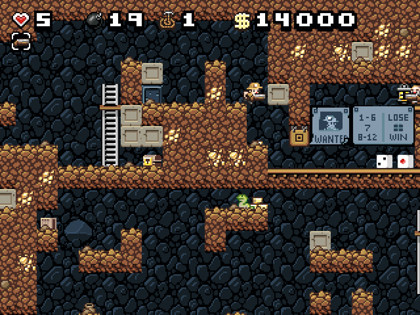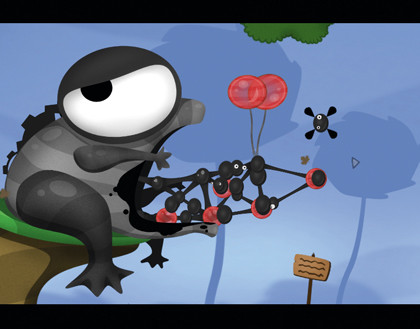Is indie gaming the future?
When failure costs millions, do indies offer a solution?
Independent games' most valuable asset is that they don't have to sell millions of units to be successful, which lets creators both target smaller niches and experiment with more interesting ideas than big publishers' games.
Inventive, completely creative games like Psychonauts or Startopia usually die in the market, no matter how good the names attached to them, or how much everything from reviews to other gamers scream to give them a chance. Instead, what the industry considers an innovative game is typically doing something safe with bolt-ons.
Bioshock, for instance, is a beautiful corridor shooter, but it's still just a corridor shooter. New genres, like the way Mirror's Edge turned parkour into a first-person experience, are spectacularly rare.
For something like Zeno Clash, a first-person melee combat game set in an organic world ruled by a depraved hermaphrodite, or The Void, in which you're a dead soul gathering colour in a purgatory filled with naked ladies, you have to go indie. On the plus side, both of these did get worldwide publishing deals. There's always hope.
Art games are a particular speciality of modern independent developers, using the language of gaming to tell stories and tap into emotions beyond alien invasions and bloodthirsty revenge. Some are narrative based, such as Digital: A Love Story (www.scoutshonour.com/digital), but others are masters of using abstract concepts to convey mood and feeling.

EVERSION:Eversion can be played as a metaphor for… well, you'll have to play it
Eversion for instance can be played as both a straightup platform game, and as a metaphor for… well, that would be giving it away. Download it from zarat.us/tra/offline-games/eversion.html. Don't Google it first.
Sign up for breaking news, reviews, opinion, top tech deals, and more.
We'll highlight one more here – Loved. It's an incredibly simple platform game on the surface, and a mean-spirited one. From the moment you start, it belittles you, gives you orders, questions your man/womanhood, tries to force you down difficult paths instead of taking the easy route, or simply expresses power by telling you to stop moving.
Whether you obey or rebel alters the level in subtle ways, neither right nor wrong. Is the voice showing tough love, or just being cruel? Is it worth harming your own progress just to spite it? The more you rebel, the harder the game becomes, but the more the originally monochrome graphics begin sparkling with colour.
With full subservience comes an easier path, but one forever cast in shadow. If art makes you think, games like this demonstrate that yes, games can be art.
The independent look
Art is however a growing problem for independent games that are being developed now. As much as people claim that gameplay is more important than graphics, and as popular as simple pixel art and the retro look is in games like VVVVV (thelettervsixtim.es) or Spelunky (www.spelunkyworld.com), production values are important.

SPELUNKY: Look at it. You will love it. You will hate it. It will beat you. You will return to it
A game has to look like it's worth the money being charged, especially with games like World of Goo (www.worldofgoo.com) and Braid (www.braid-game.com) very publicly raising the bar.
The trouble is that these things don't come cheap. Braid for instance looks like a cheap game, coded and designed by Jonathan Blow, but in practice it had a claimed budget of $180,000 and spent three years in development. Designers may work for love, but contractees usually want cash.

BRAID: The time-travelling platformer, Braid is easily one of the most ambitious indie games of the last few years. But what does it all mean?
The silly approach is to try and take on the likes of EA and Ubisoft with a tiny fraction of the budget. Instead, there are three basic schools of thought – to actively not care, to bite the bullet, or to find a new style that nobody else has used, making your game stand out of the crowd by default.
Jeff Vogel of Spiderweb Software is one of the former kind, having spent the last ten years using the same basic engine and artwork for his games and relying on the fact that people who want to play traditional RPGs aren't usually graphics junkies.
The art is representational and simple, the interface not very pleasant, but get past that and you know you're in for a great game – especially in the Geneforge games. His next world, Avadon, sees a graphical level-up, but not one you're going to mistake for Dragon Age any time soon.
Dave Gilbert of Wadjet Eye Games is a great example of the second school of thought. While making his freeware adventures, Microsoft Paint was sufficient. When he moved into making his games commercially, it was time to start contracting out.
Adventures rely on graphics, character design and animation much more than RPGs, especially if they're going for atmosphere, like his main series has, the wonderful ghostly mystery series The Blackwell Legacy. Compare the graphics of its effective pilot episode, Bestowers of Eternity, with the gorgeous painted art of the latest instalment. Money well spent.

THE BLACKWELL LEGACY: Creating atmosphere this detailed can cost money
As for the third style, they don't come much more impressive than Love – a beautiful, procedurally generated MMO written by just one man, Eskil Steenberg. Its painted, abstract worlds are instantly recognisable, and unlike anything else out there. Other approaches include olde-time noir style of The Misadventures of P.B.
From here to there
One of the main reasons that independent games are having to step up is that the distance between them and standard commercial games is drawing ever thinner. Instead of being in two separate worlds, the move towards digital distribution means that they're both fighting in the same arenas.
On Steam, a multi-million dollar game and a one-man design may not be quite equal, but they're damn close. On Xbox, the dedicated Live Arcade section still segregates 'proper' games from homebrew titles, but the fact that both are in the same store clearly points the way forward.
Digital distribution services like this also offer a number of bonuses over going it alone, including not having to persuade customers to hand over their payment details to someone they don't know, and catching the browsing audience who just wants to play a new game while waiting for the next big releases.
Going digital also offers lots of potential for new business strategies. Eversion, for instance began as a free downloadable game, but is now available commercially with better graphics.

CHANGING THE GAME: World of Goo began as a tech-test, Tower of Goo
Games that have been out for a while can return in force with a clever marketing gimmick, such as the recent trend of 'pay what you want' schemes. World of Goo, for instance is usually $20, but for a brief period, creators 2D Boy let people pick their own price. The average paid was $2.03, but with over 57 thousand people taking 2D Boy up on its offer, the result was a solid stack of cash – especially compared to the nothing that they'd otherwise have been pulling in.
A more recent collection of games, The Humble Indie Bundle, offered a similar pay-what-you-want for a collection of variably old games that have long since faded from mass attention, pulling in $1,273,613 (of which 30 per cent went to charity, a split chosen by the purchasers when choosing how much to pay).
The price of freedom
One of the most interesting things about the current indie market is how much people in the industry are starting to gaze longingly in its direction. As teams get bigger, individual contributions and input become less, and for people who got into the industry to make games, the freedom to make what they want is highly compelling. Lest we forget, for every Sid Meier, there are hundreds of programmers and artists slaving away on a bad movie licence or generic sequel.
The tools are now available to let artists script games, or programmers create art, and more importantly, keep the profits instead of drawing a salary. It's a risk, but if you've got to go down, you may as well do so doing something you love.
-------------------------------------------------------------------------------------------------------
First published in PC Format Issue 243
Liked this? Then check out 10 of the coolest demoscene creations
Sign up for TechRadar's free Weird Week in Tech newsletter
Get the oddest tech stories of the week, plus the most popular news and reviews delivered straight to your inbox. Sign up at http://www.techradar.com/register